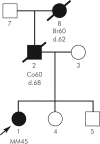Familial malignant melanoma - overview
- PMID: 20233466
- PMCID: PMC4392520
- DOI: 10.1186/1897-4287-2-3-123
Familial malignant melanoma - overview
Abstract
Approximately 3-15% of all malignant melanomas (MM) are familial cases. MM is a highly heterogeneous tumour type from a genetic perspective. Pedigrees with disease confined to a single generation of siblings or MM occurring among second- or third-degree relatives suggest multifactorial polygenic inheritance. However, not infrequently, within large families aggregations of MM are consistent with autosomal dominant inheritance, suggesting a hereditary syndrome caused by germline alterations of a single gene. Several different genes are involved in the development of MM. However, even when taken together they are responsible for less than 20% of all MM cases. It is thus necessary to perform association studies focused on genetic markers that could be used in identifying patients with a high risk of MM. Evaluation of aggregations of MM and other malignancies, like breast cancer, could be essential in identifying relatives of MM probands being at high risk of developing malignancies other than MM. The ultimate goal is to apply in these cases prevention recommendations and surveillance protocols to reduce the disease risk.
Figures
Similar articles
-
Prophylactic Oophorectomy: Reducing the U.S. Death Rate from Epithelial Ovarian Cancer. A Continuing Debate.Oncologist. 1996;1(5):326-330. Oncologist. 1996. PMID: 10388011
-
The genetics of hereditary melanoma and nevi. 1998 update.Cancer. 1999 Dec 1;86(11 Suppl):2464-77. doi: 10.1002/(sici)1097-0142(19991201)86:11+<2464::aid-cncr3>3.0.co;2-f. Cancer. 1999. PMID: 10630172 Review.
-
Increased risk of breast cancer in relatives of malignant melanoma patients from families with strong cancer familial aggregation.Eur J Cancer Prev. 2003 Jun;12(3):241-5. doi: 10.1097/00008469-200306000-00013. Eur J Cancer Prev. 2003. PMID: 12771565
-
Statewide Retrospective Review of Familial Pancreatic Cancer in Delaware, and Frequency of Genetic Mutations in Pancreatic Cancer Kindreds.Ann Surg Oncol. 2016 May;23(5):1729-35. doi: 10.1245/s10434-015-5026-x. Epub 2016 Jan 4. Ann Surg Oncol. 2016. PMID: 26727920
-
Genetic insights into familial cancers-- update and recent discoveries.Cancer Lett. 2002 Jul 26;181(2):125-64. doi: 10.1016/s0304-3835(02)00023-x. Cancer Lett. 2002. PMID: 12175530 Review.
Cited by
-
Mechanisms and prevention of UV-induced melanoma.Photodermatol Photoimmunol Photomed. 2018 Jan;34(1):13-24. doi: 10.1111/phpp.12329. Epub 2017 Aug 2. Photodermatol Photoimmunol Photomed. 2018. PMID: 28703311 Free PMC article. Review.
-
Effect of lentivirus-mediated shRNA inactivation of HK1, HK2, and HK3 genes in colorectal cancer and melanoma cells.BMC Genet. 2016 Dec 22;17(Suppl 3):156. doi: 10.1186/s12863-016-0459-1. BMC Genet. 2016. PMID: 28105937 Free PMC article.
-
Effect of hypoxia factors gene silencing on ROS production and metabolic status of A375 malignant melanoma cells.Sci Rep. 2021 May 14;11(1):10325. doi: 10.1038/s41598-021-89792-2. Sci Rep. 2021. PMID: 33990669 Free PMC article.
-
Eleven Years of Oncogenetic Consultations in a Swiss Center: Patient and Testing Characteristics.Appl Clin Genet. 2023 Nov 9;16:205-213. doi: 10.2147/TACG.S410261. eCollection 2023. Appl Clin Genet. 2023. PMID: 37965626 Free PMC article.
-
Pediatric melanoma and aggressive Spitz tumors: a retrospective diagnostic, exposure and outcome analysis.Transl Pediatr. 2018 Jul;7(3):203-210. doi: 10.21037/tp.2018.01.03. Transl Pediatr. 2018. PMID: 30159246 Free PMC article.
References
-
- Armstrong BK, Kricker A. Cutaneous melanoma. Cancer Survey. 1994;19:219–240. - PubMed
LinkOut - more resources
Full Text Sources


